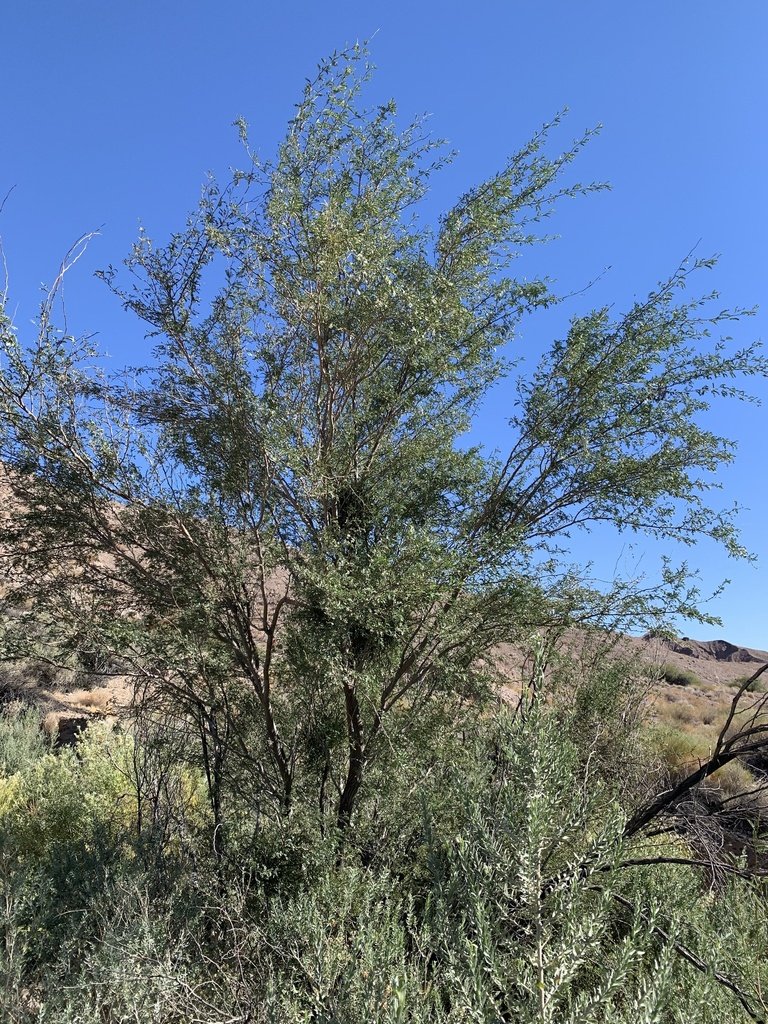Screwbean Mesquite
Strombocarpa pubescens
NOTE: mesquites have gone through a big taxonomic shift. This plant is still widely known as Prosopis pubescens.
Family: Fabaceae
CHARACTERISTICS
Small to medium sized tree reaching about 30’ tall, often only 15-20’. Typically bloom May to June with fuzzy yellow catkin flowers, followed by unusual corkscrew seed pods.
LANDSCAPE USE
Small to medium landscape tree.
GROWING CONDITIONS
AN EXPLANATION OF TERMS USED
SUN full sun
WATER moderate to riparian
SOIL prefers sandy or rocky soil, amendments encouraged
HARDINESS hardy to about 0°F
BASIN middle zone
CONTAINER does ok in container but will not attain full size
NUTRITION low
MAINTENANCE very little
Photo by Duncan Bell, iNaturalist
Prosopis pubescens on SEINET
ECOLOGY
Larval host for the Reakirt's blue butterfly (Hemiargus isola), Marine Blue (Leptotes marina), the Ceraunus Blue (Hemiargus ceraunus), the Palmer's Metalmark (Apodemia palmerii), the Black Witch Moth (Ascalapha odorata), the Juno Buckmoth (Hemileuca juno), and many other moths. Important nectar plant for numerous insects, attracting insectivorous birds, pods & seeds edible to people, birds & mammals, nesting habitat for birds. Blamed for allergy problems but these plants have sticky pollen which has evolved to stick to bees not fly in the air—they happen to bloom when many grasses and other allergenic plants bloom and get blamed for allergies. Many types of animals readily eat the seedpods, including several bird and rodent species and coyotes. Many species of birds nest and roost in the trees, and small mammals find shelter in thicketlike stands.
ETHNOBOTANY
Like those of other Prosopis species, Screwbean Mesquite has nutritious seedpods that can be eaten which makes it an important food resource in our region. The wood is valuable for building, for making tools and weapons, and as firewood—because it is durable and considered attractive, and it is used in fine woodworking. Some Native Americans also use the root bark to prepare a treatment for wounds.
NATURAL DISTRIBUTION
Screwbean mesquite is found along streams and valleys in deserts, particularly in damp or saline soil in California, Arizona, Nevada, New Mexico, Texas, and neighboring Mexico. Unlike other species of mesquites, is more rare in nature than it used to be.
TAXONOMY AND NAME
This species was previously known as Prosopis pubescens.
This species is in the Fabaceae, the legume family. There are 11 accepted species in the genus Strombocarpa native to the southwestern United States and northern Mexico, or to southern South America from Peru through Bolivia and northern and central Chile to southern Argentina.
Prosopis was a Greek name for burdock (seemingly a misnomer), the species epithet “pubescens” (1760 Biology term - pubescent) means “covered with fine soft, short hairs or down”. The new genus strombocarpa is broken down into Strombo- (Italian. = conch) and -carpa (Gk. = fruit), referring to the resemblance of the fruits to the spiral shells of tropical marine mollusks.
The bean pods are most distinctive in our region--they are coiled. Photo by lonnyholmes, iNaturalist
When not blooming or fruiting, one might mistake this species for an acacia. Foliage detail of screwbean mesquite by Sophia Winitsky, iNaturalist
This species used to be much more prevalent, especially along the Colorado River. But as the Colorado (and other riparian zones) has shrunken, so has the population of screwbean mesquite. Photo by Denver Billing, iNaturalist
The flowers are usually yellow, rod-shaped catkins. Photo by Liz Makings, SEINET





